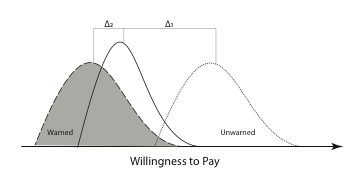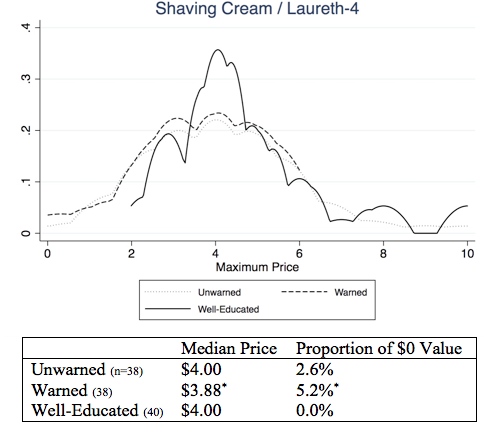The Volokh Conspiracy
Mostly law professors | Sometimes contrarian | Often libertarian | Always independent
The value of mandated informational disclosures assessed

My last post listed mandated informational disclosures as a means to promote consumer education without using censorship rules. Mandated disclosures are an appealing option to help consumers make better-educated decisions. In theory, compelled informational disclosures can help reduce some of the foreseeable failures in the marketplace of ideas by adding good information rather than subtracting the bad.
Federal and state regulators have used informational disclosures to try to nudge consumers into thinking about the "full price" rather than the sticker price of goods, and to nudge retailers and manufacturers into avoiding harmful practices. But the results have been mixed.
Some disclosure regimes changed the market for the better without heavy-handed restrictions. For example, the introduction of restaurant grades in Los Angeles appears to have improved compliance with public health codes. But many mandated disclosures, possibly even most, do not achieve their goals of consumer education.
Omri Ben-Shahar's and Carl E. Schneider's book, More Than You Wanted to Know: The Failure of Mandated Disclosure, which expands an earlier article, provides an explanation and examples for why mandated disclosures fail to change behavior. One key theme is that disclosure overload allows important information to fall into the background din. Moreover, disclosures can do worse than nothing; they can actually make markets worse. Daniel Ho's article, Fudging the Nudge: Information Disclosure and Restaurant Grading, shows that contrary to the results from Los Angeles, restaurant letter grading systems did not improve hygiene in most cities because the disclosure systems were quickly distorted by grade inflation and inconsistency.
Mandated disclosure can also lead to pernicious gaming, as seems to be the case with hospital grading systems. To get better grades, hospitals do all they can to avoid the sickest patients. Also, highly visible and salient disclosures can over-correct for the problem they are attempting to address, as seems to be the case with black box warnings on antidepressants. Or they can be so discouraging that the consumer makes worse decisions than he otherwise would. When Mexico tried an innovative disclosure system that alerted debtors about the magnitude of their credit problems, the disclosures caused default rates to go up.
For a long while, First Amendment law had little to say about mandated disclosures. In Zauderer v. Office of Disciplinary Counsel, the Supreme Court found that compelled informational disclosures, as opposed to compelled ideological disclosures, were permissible regulations on commercial actors. But Zauderer is now on shaky ground, in part because of the proliferation and problems with mandated informational disclosures, and in part because the line between "informational" and "ideological" disclosures is blurry. Consider requirements in Texas that abortion providers perform a sonogram and show the patient her fetus before terminating the pregnancy. (The Fifth Circuit upheld the law, but the opinion is controversial.)
Regular Volokh conspirator Jonathan Adler has taken up the issue of compelled informational speech in his work, which has been influential in my thinking. Adler argues that mandated disclosures concerning product attributes other than basic product contents and functions should trigger the heightened scrutiny that normally applies in compelled speech cases.
In a recent article, A Bad Education (published by the University of Illinois Law Review), my coauthors and I propose a way to assess mandated informational disclosures as a matter of good policy. (In a related piece, I adapted the methodology for use in compelled speech cases.)
We used vignettes in an experimental setting to see whether mandated disclosures concern a material latent attribute, and whether they cause an overreaction. Here's the theory behind the work: Imagine we knew the highest price a person would be willing to pay for a particular product under three conditions. In the "unwarned" condition, the consumer uses only their preexisting knowledge and assumptions about the product attribute that is of interest. In the "warned" condition, the consumer is given a simple disclosure in the style of a just-in-time mandated disclosure. In the "perfectly informed" condition, the consumer has as much knowledge about the product attribute as experts.
If we were to plot out the distribution of prices that all consumers were willing to pay for the product under all three of these conditions, we would see curves that look something like this:

Δ1 measures whether mandated disclosures are material for the majority of consumers. If Δ1> 0, then consumers care about the latent attribute on average, and their consumption decisions may be benefited from a disclosure regime.
But mandated disclosures cannot make consumers perfectly informed. The best they can realistically do is provide a quick alert and rough education about the latent attribute. It's possible that this realistic warning may not actually shift consumer behavior, in which case the warning is useless. It's also possible that the warning can cause an overreaction, which is illustrated here as Δ2. If the overreaction is significant, if it is greater than Δ1, for example, then the mandated disclosure may be harmful to the market even if the latent attribute is a material one.
These concepts could be useful for First Amendment law, too. Compelled disclosures that are either useless (about non-material attributes) or misleading (that cause over-correction) are arguably unconstitutional because they needlessly or harmfully interfere with communications.
In our experiment, we randomized subjects into three conditions-unwarned, warned, and "well-educated" (the closest we could get to "perfectly informed" by supplying additional information about the costs and benefits about the latent attribute) to see how their willingness to pay was affected by the information they received. Here's an example of what a disclosure about an ingredient used in shaving cream did to willingness to pay. The subjects saw either the first line of information, the first and second, or all the information, depending on what group they were assigned to:

Their willingness to pay was affected by the disclosure levels:

Subjects who saw the warning without having additional information about what the chemical "Laureth-4" does were naturally wary of it. But with more information about its benefits and lack of risk, the curve returned to where it was without a warning. This example illustrates a non-material attribute (Δ1 = 0) and an over-reaction (Δ2>0).
It would obviously be unwise for the government to mandate disclosures about "laureth-4." We used the shaving cream example to make sure that our methodology was sound-that it would pick up the effects of warnings and of education. If we didn't get the results we see above, we would have worried that the experimental design was flawed. But with the reassurance of these results, we tested a range of other product attributes, some of which came from actual First Amendment compelled disclosure controversies.
Warnings about drug side effects and conflict minerals produced results that suggest the disclosures were material and did not cause over-reaction. (The finding on conflict minerals is interesting in light of a recent case before the D.C. Circuit Court of Appeals that struck down SEC laws mandating disclosure of conflict diamonds.) The labeling of a GMO food, on the other hand, appeared to be non-material and to cause an overreaction - findings equivalent to the "Laureth-4" example. Disclosures related to privacy (data collection by an email provider, data sales, and the use of de-identified research data) seem to be non-material, although as we explain, the results for data selling are peculiar and interesting.
Our study results are tentative, meant to provide just a proof of concept for the methods. Our sample sizes were good but not great, and some will quibble with the way we characterized risks and benefits for the "well-educated" groups of research subjects. But the theory and methods, if not the specific results, can add value and precision to the debates about mandated disclosure. Lawmakers and courts ought to be asking whether prospective listeners in a mandated disclosure regime actually care about the information that is being provided, or if instead the disclosure is being used by the government to create a concern that does not actually exist.


Show Comments (0)